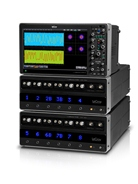
The device includes a number of industry firsts. Four oscilloscope channels, all at silicon-based 36 GHz bandwidth (the highest available) and 80 GS/s sample rate in a single acquisition module, provide twice the bandwidth density of competitive oscilloscopes.
The company’s patented Digital Bandwidth Interleave (DBI) technology allows extension of the silicon-based 36 GHz bandwidth and 80 GS/s sample rate to 60 GHz and 160 GS/s by combining two 36 GHz channels. The 60 GHz real-time bandwidth is also an industry first, and is nearly twice the bandwidth rating of competitive 32 and 33 GHz oscilloscopes with an equivalent number of channels. Furthermore, LeCroy’s proprietary ChannelSync technology in the LabMaster 10 Zi oscilloscopes permits precise synchronization of up to twenty silicon-based 36 GHz / 80 GS/s channels and up to ten 60 GHz / 160 GS/s DBI channels-capability.
The LabMaster 10 Zi’s trigger bandwidth is 30 Ghz, twice that of the WaveMaster 8 Zi-A and LabMaster 9 Zi-A oscilloscopes. The Jitter Noise Floor is very low and the rise time (20-80%) is 5.5 ps for the 60 GHz model, and 9.75 ps for the 36 GHz model. In addition, a 14.1 Gb/s 80-bit serial pattern trigger with support for 8b/10b and 64b/66b symbol triggering and PCI Express Generation 3.0 will be optionally available for LabMaster 10 Zi models. This trigger significantly enhances the value of LabMaster 10 Zi for high speed serial data debugging by providing ability to isolate errors to specific symbols and PCI Express link layer.
The 36 GHz chipset is based on 8HP SiGe. SiGe is a widely adopted, mainstream, commercial process backed by chip technology leader IBM Semiconductor. IBM’s 8HP SiGe process is the fourth-generation SiGe process with two times the performance of the previous generation and up to 200 GHz transistor switching speeds.
DBI, a proprietary, patented LeCroy technology, provides the ability to double or triple the bandwidth available in raw silicon by splitting a high bandwidth signal into multiple paths of lower bandwidth, acquiring these lower bandwidth signals with best-in-class silicon chip technologies, and then re-assembling the separate lower bandwidth paths into a single high bandwidth path using digital signal processing (DSP). Sample rate and acquisition memory are likewise doubled or tripled along with the bandwidth.
The LabMaster modular oscilloscope architecture separates the oscilloscope signal acquisition function from the display, control, and processing functions. The LabMaster Master Control Module (MCM-Zi) contains the display, controls, ChannelSync architecture, and a powerful server-class CPU. By using ChannelSync technology, up to five LabMaster 10 Zi Acquisition Modules can be synchronized, extending the channel density performance by a factor of five to achieve up to 20 channels at 36 GHz and 10 channels at 60 GHz.
To meet a variety of industry needs, LeCroy is also announcing models with silicon-based 25 and 30 GHz of bandwidth, each with 80 GS/s sampling rate on each channel.
Standard memory is 20 Mpts/ch (on all four channels, doubled when channels are bandwidth interleaved) with memory options of 32, 64, 128, 256 and 512 Mpts/ch. Maximum analysis memory of 512 Mpts/ch (36 GHz) and 1024 Mpts/ch (60 GHz) is an industry first, combining long acquisition captures with long memory analysis capability and advanced eye diagram/jitter analysis with the world’s fastest and highest bandwidth density oscilloscopes.
Cloud computing demands are driving rapid developments in buildouts of 28 GBaud (112 Gb/s) DP-QPSK optical coherent modulation systems. For 28 GBaud testing, a LabMaster 10 Zi silicon-based 36 GHz oscilloscope provides a cost-effective solution with low noise.
Research is already progressing on >56 GBaud (224 Gb/s) DP-QPSK and 16-QAM optical coherent modulation systems. LabMaster 10 Zi can be configured as a 2 to 4 channel 60 GHz system to allow research at the highest possible symbol rates, approaching 125 GBaud (500 Gb/s) for DP-QPSK or 1 Tb/s for 16-QAM.
Lastly, optical transmission developments beyond 1 Tb/s will likely make use of lower data transmission rates but mode or frequency domain multiplexing, such as MIMO or OFDM, will require more than the four acquisition channels commonly provided in conventional oscilloscopes. LabMaster 10 Zi modular oscilloscopes provide up to 20 channels at 36 GHz or 10 channels at 60 GHz, thus making possible the development of advanced optical communication systems that would otherwise not be feasible.
 CIE Components in Electronics
CIE Components in Electronics
